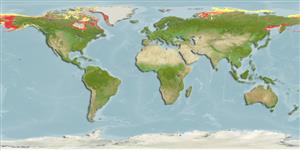Environment: milieu / climate zone / depth range / distribution range
Écologie
marin démersal; profondeur 0 - 94 m (Ref. 50550), usually 30 - 46 m (Ref. 48978). Polar; 83°N - 40°N, 136°E - 42°W
Western Atlantic: Arctic Ocean to southern Labrador, Canada and western Greenland. North Pacific: Japan (Ref. 559) and Alaska (Ref. 11366).
Taille / Poids / Âge
Maturity: Lm ? range ? - ? cm
Max length : 30.0 cm TL mâle / non sexé; (Ref. 7251)
Description synthétique
Clés d'identification | Morphologie | Morphométrie
Épines dorsales (Total) : 80 - 83; Épines anales: 2; Rayons mous anaux: 38 - 42; Vertèbres: 87 - 90.
Facultative air-breathing (Ref. 126274); Entirely subtidal (Ref. 48978). Benthic; feeds on crustaceans and worms (Ref. 58426).
Life cycle and mating behavior
Maturities | Reproduction | Spawnings | Egg(s) | Fecundities | Larves
Robins, C.R. and G.C. Ray, 1986. A field guide to Atlantic coast fishes of North America. Houghton Mifflin Company, Boston, U.S.A. 354 p. (Ref. 7251)
Statut dans la liste rouge de l'IUCN (Ref. 130435)
Menace pour l'homme
Harmless
Utilisations par l'homme
Outils
Articles particuliers
Télécharger en XML
Sources Internet
Estimates based on models
Preferred temperature (Ref.
123201): -1.4 - 2.8, mean 0 °C (based on 367 cells).
Phylogenetic diversity index (Ref.
82804): PD
50 = 0.5005 [Uniqueness, from 0.5 = low to 2.0 = high].
Bayesian length-weight: a=0.00162 (0.00068 - 0.00388), b=3.19 (2.99 - 3.39), in cm total length, based on LWR estimates for this (Sub)family-body shape (Ref.
93245).
Niveau trophique (Ref.
69278): 3.3 ±0.39 se; based on food items.
Résilience (Ref.
120179): Milieu, temps minimum de doublement de population : 1,4 à 4,4 années (Preliminary K or Fecundity.).
Fishing Vulnerability (Ref.
59153): Low vulnerability (20 of 100).
